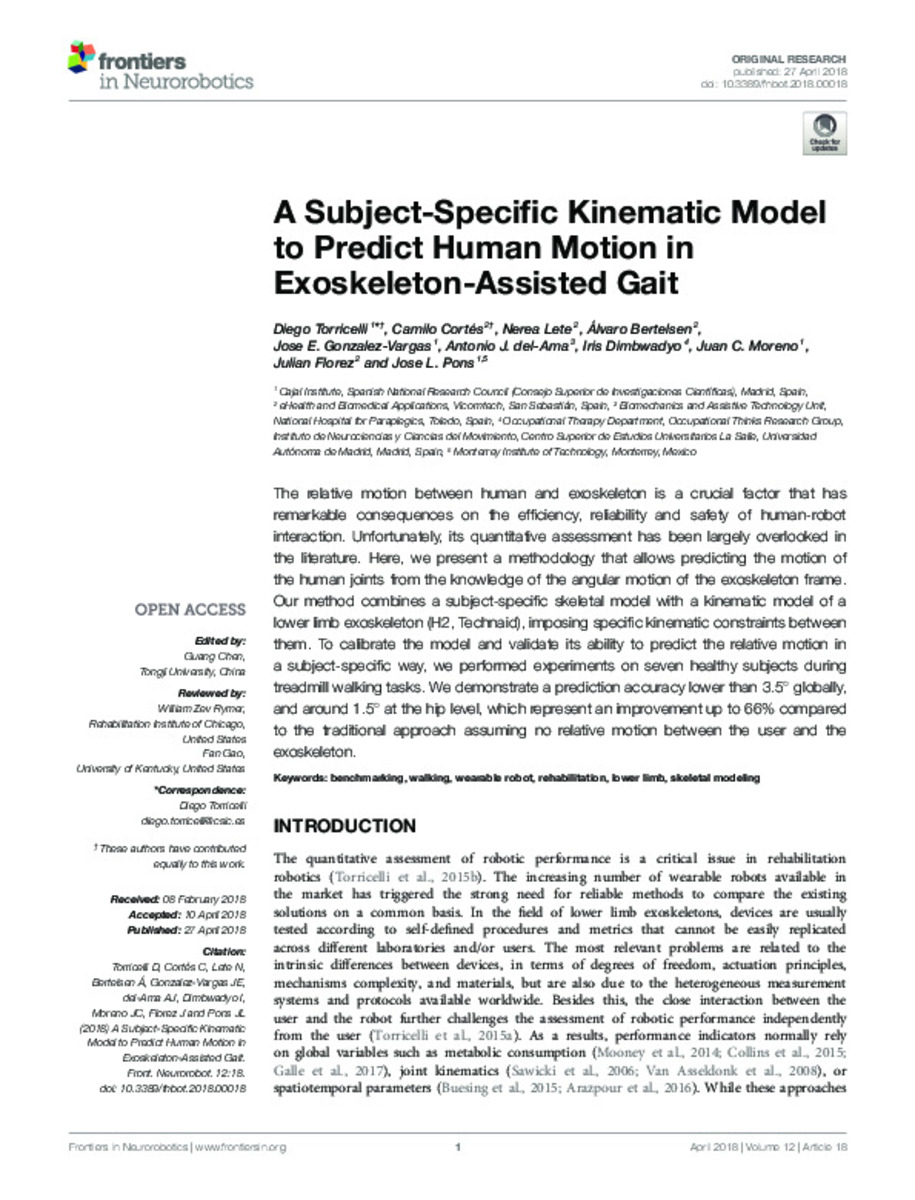Full metadata record
| DC Field | Value | Language |
|---|---|---|
| dc.creator | Torricelli, D. (Diego) | - |
| dc.creator | Cortés, C. (Camilo) | - |
| dc.creator | Lete, N. (Nerea) | - |
| dc.creator | Bertelsen-Simonetti, A. (Álvaro) | - |
| dc.creator | Gonzalez-Vargas, J.E. (José E.) | - |
| dc.creator | del-Ama, A.J. (Antonio J.) | - |
| dc.creator | Dimbwadyo, I. (Iris) | - |
| dc.creator | Moreno-Sastoque, J.C. (Juan C.) | - |
| dc.creator | Florez, J. (Julian) | - |
| dc.creator | Pons, J.L. (José L.) | - |
| dc.date.accessioned | 2023-01-31T11:37:20Z | - |
| dc.date.available | 2023-01-31T11:37:20Z | - |
| dc.date.issued | 2018 | - |
| dc.identifier.citation | Torricelli, D. (Diego); Cortés, C. (Camilo); Lete, N. (Nerea); et al. "A subject-specific kinematic model to predict human motion in exoskeleton-assisted gait". Frontiers in neurorobotics. 12, 2018, 18 | es |
| dc.identifier.issn | 1662-5218 | - |
| dc.identifier.uri | https://hdl.handle.net/10171/65223 | - |
| dc.description.abstract | The relative motion between human and exoskeleton is a crucial factor that has remarkable consequences on the efficiency, reliability and safety of human-robot interaction. Unfortunately, its quantitative assessment has been largely overlooked in the literature. Here, we present a methodology that allows predicting the motion of the human joints from the knowledge of the angular motion of the exoskeleton frame. Our method combines a subject-specific skeletal model with a kinematic model of a lower limb exoskeleton (H2, Technaid), imposing specific kinematic constraints between them. To calibrate the model and validate its ability to predict the relative motion in a subject-specific way, we performed experiments on seven healthy subjects during treadmill walking tasks. We demonstrate a prediction accuracy lower than 3.5◦ globally, and around 1.5◦ at the hip level, which represent an improvement up to 66% compared to the traditional approach assuming no relative motion between the user and the exoskeleton. | es_ES |
| dc.description.sponsorship | This work was supported by the FP7 Project BioMot Smart Wearable Robots with Bioinspired Sensory-Motor Skills, grant agreement n◦ 611695, and the H2020 Project EUROBENCH European Robotic framework for bipedal locomotion benchmarking, grant agreement n◦ 779963. | es_ES |
| dc.language.iso | eng | es_ES |
| dc.publisher | Frontiers Media | es_ES |
| dc.relation | info:eu-repo/grantAgreement/EC/FP7/611695/EU | es_ES |
| dc.relation | info:eu-repo/grantAgreement/EC/H2020/779963/EU | es_ES |
| dc.rights | info:eu-repo/semantics/openAccess | es_ES |
| dc.subject | Benchmarking | es_ES |
| dc.subject | Walking | es_ES |
| dc.subject | Wearable robot | es_ES |
| dc.subject | Rehabilitation | es_ES |
| dc.subject | Lower limb | es_ES |
| dc.subject | Skeletal modeling | es_ES |
| dc.title | A subject-specific kinematic model to predict human motion in exoskeleton-assisted gait | es_ES |
| dc.type | info:eu-repo/semantics/article | es_ES |
| dc.description.note | This is an open-access article distributed under the terms of the Creative Commons Attribution License (CC BY). The use, distribution or reproduction in other forums is permitted, provided the original author(s) and the copyright owner are credited and that the original publication in this journal is cited, in accordance with accepted academic practice. No use, distribution or reproduction is permitted which does not comply with these terms. | es_ES |
| dc.identifier.doi | 10.3389/fnbot.2018.00018 | - |
| dadun.citation.publicationName | Frontiers in neurorobotics | es_ES |
| dadun.citation.startingPage | 18 | es_ES |
| dadun.citation.volume | 12 | es_ES |
Files in This Item:
Statistics and impact
Items in Dadun are protected by copyright, with all rights reserved, unless otherwise indicated.






